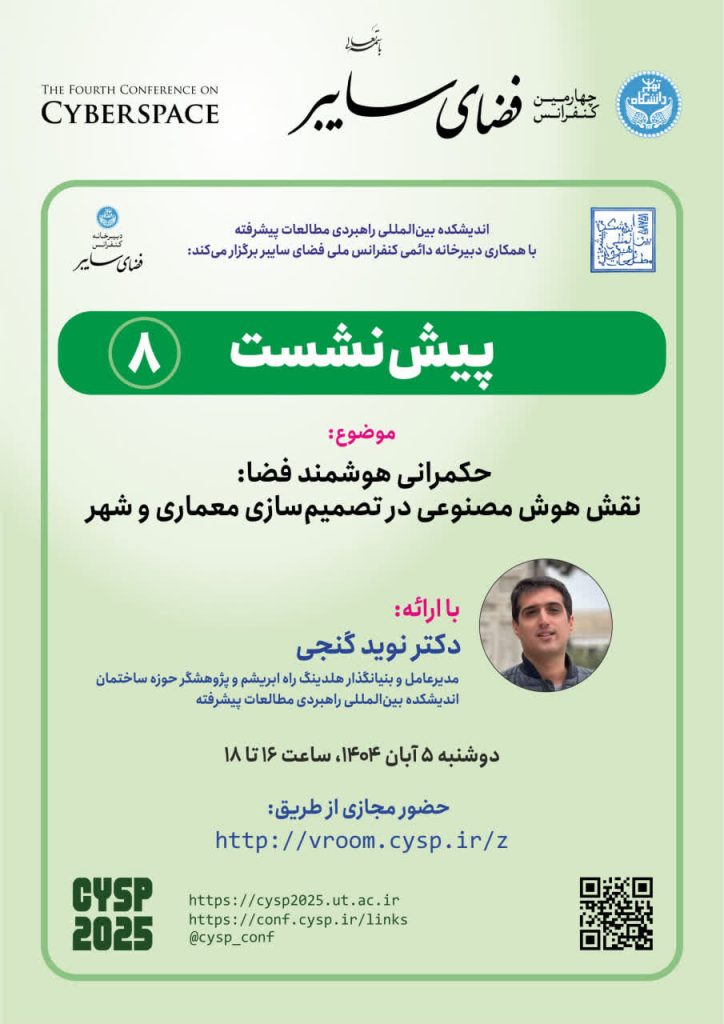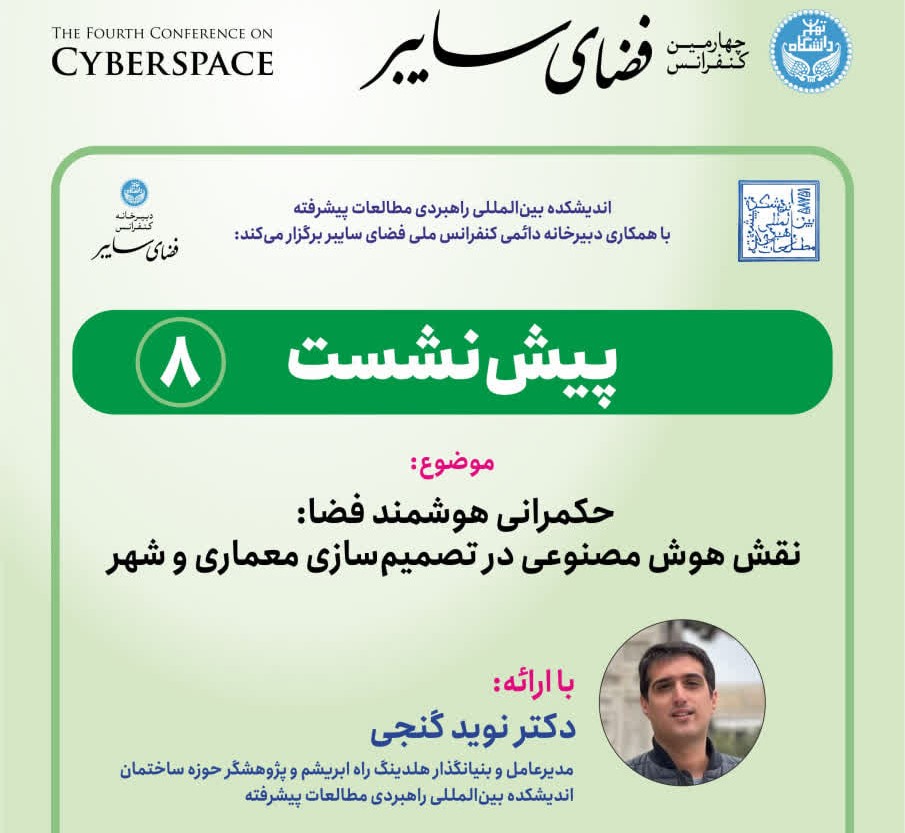Panel Session Report: Smart Governance of Space – The Role of AI in Architectural and Urban Decision-Making

Event Overview On October 26, 2025, the Fourth Conference on Cyberspace (CYSP 2025) hosted Panel Session 8 in a virtual room, drawing over 200 participants from academia, industry, and government sectors. The session, titled Smart Governance of Space: The Role of Artificial Intelligence in Architectural and Urban Decision-Making, was presented by Dr. Navid Ganji, CEO and Founder of Silk Road Holding, and a researcher in building domains at the International Strategic Studies Think Tank for Advanced Studies. Dr. Ganji, with his extensive background in AI applications for urban development, delivered a compelling 90-minute presentation followed by a lively Q&A. The talk emphasized how AI is reshaping spatial governance, turning data into a foundational asset for sustainable, intelligent cities. Attendees included urban planners, architects, policymakers, and tech enthusiasts, with real-time polls revealing that 78% of participants were already integrating AI tools in their workflows but sought deeper insights on ethical and practical implementation.
Dr. Ganji opened with a provocative statement: “In the 21st century, data isn’t just oil—it’s the very soil on which we build our cities.” He framed the discussion around four key axes, blending theoretical frameworks with real-world case studies, and highlighted the urgency of AI adoption amid rapid urbanization and climate challenges. The session was streamed live via http://vroom.cysp.ir/z, with recordings available on the conference website and social channels (@cysp_conf). Below is a detailed summary of the content covered.
Axis 1: Data as the New Infrastructure for Spatial Governance
Dr. Ganji began by arguing that traditional urban infrastructure—roads, utilities, and buildings—is being eclipsed by digital layers of data, forming what he called “the invisible backbone of modern cities.” He drew on geospatial data solutions, explaining how tools like GIS (Geographic Information Systems) and IoT sensors enable real-time analytics for predictive modeling, resource optimization, and resilient frameworks. For instance, he referenced how cities are using big data to optimize infrastructure like lighting and water usage, manage traffic flow, and enhance public safety, as seen in comprehensive urban datasets that integrate environmental, demographic, and economic layers.
Expanding on this, Dr. Ganji discussed Spatial Data Infrastructure (SDI) as a critical framework, citing examples from Sweden where data availability bridges gaps in implementing blue-green infrastructure (BGI) for sustainable planning. He highlighted China’s spatio-temporal big data platforms for building digital and smart cities, which improve management levels through integrated systems. In a data-powered urban planning context, he noted PwC’s insights on leveraging vast digital arrays to inform and optimize decisions, emphasizing that data permeates everything from traffic planning to physical manifestations like data farms.
To illustrate, Dr. Ganji shared a case from Monterrey, Mexico, where an SDI for urban development ensures data-driven decision-making under open government principles, guaranteeing the right to the city. He warned of challenges, such as data silos and privacy concerns, but stressed that AI can aggregate mobile big data with national SDI for local spatial planning, as explored in recent Polish studies. The axis concluded with a call for policymakers to treat data as a public good, akin to physical infrastructure, to foster equitable governance.
Axis 2: The Architect’s Role in the Data Era
Shifting focus to human elements, Dr. Ganji explored how architects are evolving from traditional designers to “curators of algorithmic creativity.” He described a paradigm where AI tools, such as generative design and BIM (Building Information Modeling) integrated with machine learning, allow architects to co-create with algorithms. This shift, he explained, frees professionals from repetitive tasks, enabling them to balance aesthetics, functionality, and ethics in automated workflows.
Citing benefits from tools like Digital Blue Foam, Dr. Ganji noted that generative AI transforms architects’ roles by automating workflows and generating designs based on inputs like owner requirements, building codes, and climate data. He referenced Bernard Marr’s analysis of how AI streamlines jobs in architecture and civil engineering, empowering professionals to focus on high-level strategy. Parangat Technologies’ insights were invoked to show how AI analyzes big data for smarter choices, uncovering design ideas that humans might overlook.
Dr. Ganji delved into ethical considerations, such as bias in AI-generated designs and the need for human oversight. He highlighted studies demonstrating AI’s enhancement of generative design, spatial organization, and sustainable architecture, with 46% of projects already using AI for efficiency gains. Tools like Rhino+Grasshopper with ML plugins were demonstrated via live examples, showing how architects can iterate thousands of designs rapidly. He concluded this section by urging architects to embrace AI not as a replacement but as a collaborator, reshaping fee structures and business models in the process.
Axis 3: Global Models of Smart Governance (Singapore, Seoul, Dubai)
Dr. Ganji presented three exemplary cities as blueprints for AI-driven spatial governance, emphasizing scalability, public-private partnerships, and cultural adaptation for emerging economies.
- Singapore’s Virtual Singapore Platform: Described as a high-resolution 3D digital twin, this model integrates real-time data on buildings, infrastructure, and population movements for simulation-based policy testing. Dr. Ganji detailed how it serves as a collaborative platform, allowing urban planners to experiment with scenarios like flood mitigation or energy optimization. He referenced its role in building a “3D-empowered smart nation,” where topographical and dynamic data create an immersive virtual model for decision-making.
- Seoul’s AI-Powered Systems: Focusing on traffic and emergency response, Dr. Ganji highlighted Seoul’s pioneering AI callbot for 119 emergency services, which identifies urgent incidents and connects them to operators, securing “golden time” for responses. He discussed the city’s integrated safety platform, including AI traffic drones that have halved emergency response times by navigating gridlock. Expansions to smart public safety, such as ChatGPT integrations for citizen services, were noted as ways to improve rapid responses in high-density urban environments.
- Dubai’s AI and Blockchain Integration: Dr. Ganji showcased how Dubai blends AI with blockchain for urban services, including smart parking, the Happiness Meter, and autonomous mobility. He explained the Road and Transport Authority’s (RTA) rollout of over 40 use cases, like generative AI in public services, to enhance efficiency and security. Blockchain’s role in smart city ecosystems was emphasized for driving innovation in infrastructure, with early investments transforming urban living through IoT and sustainable projects.
These case studies, Dr. Ganji argued, offer lessons in data interoperability and citizen-centric design, adaptable to regions like the Middle East for fostering resilient, inclusive cities.
Axis 4: Data-Driven Decision-Making Training for Managers and Designers
In the final axis, Dr. Ganji advocated for upskilling professionals through targeted training, recommending curricula that blend AI literacy with practical tools. He outlined hands-on workshops in data analysis, visualization, and ethical governance, drawing from programs like Macskills Development’s Urban Data Analytics course, which equips planners and officials with skills for interpreting diverse urban data.
He referenced Flexicourses’ executive programs in urban economics, focusing on data-driven strategies for accuracy and innovation. Trainingcred’s Data Analytics for Smart Cities course was highlighted for turning complex data into equitable decisions. Broader certificates, such as Georgetown SCS’s online program or ICMA’s Data-Driven Decision Making, were suggested for exploring ethical implications and systematic analysis. Dr. Ganji stressed cross-disciplinary collaboration, using examples like Atlan’s 2025 guide to leveraging insights for business strategies, and Management Concepts’ courses for building analytical skills.
He proposed a framework: Start with AI basics, progress to simulation tools, and culminate in real-world projects, ensuring managers and designers can inform evidence-based urban strategies.
Q&A and Key Takeaways The session wrapped with an interactive Q&A, where questions ranged from AI’s impact on job displacement (Dr. Ganji reassured augmentation over replacement) to implementation costs in developing nations. Polls showed 85% of attendees planning to adopt data-driven tools within the year. Key takeaways included the need for inclusive AI governance, data as a strategic asset, and continuous education to bridge the skills gap.
Overall, Dr. Ganji’s presentation bridged theory and practice, inspiring attendees to leverage AI for democratizing urban decision-making while prioritizing sustainability and human-centered design. For more details, visit the CYSP 2025 archives or follow #CYSP2025 #SmartGovernance #AIinArchitecture on social media.
Presentation File in persian : https://navidganji.ir/wp-content/uploads/2025/10/cyber-uni-tehran-navid-ganji-persian.pdf


